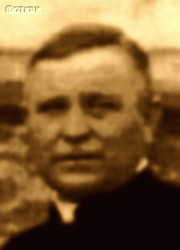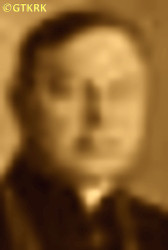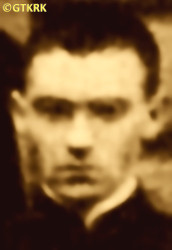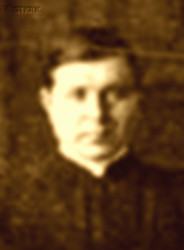Roman Catholic
St Sigismund parish
05-507 Słomczyn
85 Wiślana Str.
Konstancin deanery
Warsaw archdiocese, Poland
full list:
displayClick to display full list

searchClick to search full list by categories
wyświetlKliknij by wyświetlić pełną listę po polsku

szukajKliknij by przeszukać listę wg kategorii po polsku

Martyrology of the clergy — Poland
XX century (1914 – 1989)
personal data
surname
CHWIEĆKO
surname
versions/aliases
CHWIEĆKA
forename(s)
Lucian (pl. Lucjan)

function
diocesan priest
creed
Latin (Roman Catholic) Church RCmore on
en.wikipedia.org
[access: 2014.09.21]
diocese / province
Pinsk diocesemore on
en.wikipedia.org
[access: 2013.05.19]
Mogilev archdiocesemore on
en.wikipedia.org
[access: 2013.06.23]
academic distinctions
Sacred Theology MA
honorary titles
Papal super–numerary private honorary chamberlainmore on
Papal super-numerary private honorary chamberlain
Minor Canonmore on
Minor Canon
(Assumption of the Blessed Virgin Mary RC cathedral church, Pinsktoday: Pinsk city dist., Brest reg., Belarus
more on
en.wikipedia.org
[access: 2022.07.16])
honorary canonmore on
honorary canon
(Assumption of the Blessed Virgin Mary RC cathedral church, Pinsktoday: Pinsk city dist., Brest reg., Belarus
more on
en.wikipedia.org
[access: 2022.07.16], Assumption of the Blessed Virgin Mary and St Stanislav the Bishop and Martyr RC archcathedral church, Mogilevtoday: Mogilev dist., Mogilev reg., Belarus
more on
en.wikipedia.org
[access: 2022.01.06])
nationality
Belarusian
date and place
of death
28.04.1944

Stowbtsytoday: Stowbtsy dist., Minsk reg., Belarus
more on
en.wikipedia.org
[access: 2022.12.25]
alt. dates and places
of death
Pinsktoday: Pinsk city dist., Brest reg., Belarus
more on
en.wikipedia.org
[access: 2022.07.16]
details of death
From 10.1920 organizer and secretary of clandestine Theological Seminary in Sankt Petersburg.
Arrested by the Russians on 05.12.1922 but soon released.
Next director of the clandestine Theological Seminary in Sankt Petersburg.
10.03.1923 in Moscow arrested again by the Russians.
Tried in Abp Cieplak and his collaborators' process.
Russian prosecutor called for death penalty but on 26.03.1923 was sentenced — for participation in „counter–revolutionary organization created by Cieplak and Budkiewicz” — to 10 years of slave labour.
Exiled to ITL SLON Solovetsky Islands concentration camp.
On 01.02.1925 released and exchanged for Russian spies in Poland (among Russians sent to Russia was — according to some historians — Boleslav Bierut, future leader of Commie‐Nazi regime in Poland).
After German and Russian invasion of Poland in 09.1939 and start of the World War II, during German occupation, beaten up in 1944 (or 1943) by the Germans in Stowbtsy.
Perished in hospital in unknown circumstances.
cause of death
murder
perpetrators
Germans
sites and events
Ribbentrop‐MolotovClick to display the description, Pius XI's encyclicalsClick to display the description, ITL SLONClick to display the description, GulagClick to display the description, Trial of 21‐25.03.1923Click to display the description, Moscow (Butyrki)Click to display the description
date and place
of birth
05.12.1889

Małyszówkatoday: part of Dąbrowa Białostocka, Dąbrowa Białostocka gm., Sokółka pov., Podlaskie voiv., Poland
more on
en.wikipedia.org
[access: 2021.09.29]
alt. dates and places
of birth
22.11.1889
presbyter (holy orders)
ordination
31.05.1914

Sankt Petersburgtoday: Saint Petersburg city, Russia
more on
en.wikipedia.org
[access: 2020.07.31]
positions held
till c. 1944
parish priest — Khotovtoday: Khotova, Derevno ssov., Stowbtsy dist., Minsk reg., Belarus
more on
be.wikipedia.org
[access: 2023.01.13] ⋄ Sacred Heart of Jesus RC parish ⋄ Ivyanetstoday: Valozhyn dist., Minsk reg., Belarus
more on
en.wikipedia.org
[access: 2020.12.11] RC deanery
1933 – 1939
treasurer — Pinsktoday: Pinsk city dist., Brest reg., Belarus
more on
en.wikipedia.org
[access: 2022.07.16] ⋄ Diocesan Curia — also: vice–president of the Diocesan Economic Council and member of the Synodal Commission
c. 1933 – c. 1939
treasury officer / procurator — Pinsktoday: Pinsk city dist., Brest reg., Belarus
more on
en.wikipedia.org
[access: 2022.07.16] ⋄ St Thomas Aquinas' Theological Seminary — also: professor and lecturer of pastoral theology and Belarusian language
c. 1933 – c. 1939
Minor Canon — Pinsktoday: Pinsk city dist., Brest reg., Belarus
more on
en.wikipedia.org
[access: 2022.07.16] ⋄ Cathedral Chapter ⋄ Assumption of the Blessed Virgin Mary RC cathedral church
c. 1932
administrator — Malye Shchitnikitoday: Novyye Lyshchitsy ssov., Brest dist., Brest reg., Belarus
more on
be.wikipedia.org
[access: 2022.07.21] ⋄ Sacred Heart of Jesus RC parish ⋄ Brest on Bugform.: Brest‐Litovsk /till 1923/
today: Brest, Brest dist., Brest reg., Belarus
more on
en.wikipedia.org
[access: 2021.09.29] RC deanery — acting („ad interim”)
c. 1932
administrator — Stavytoday: Voŭčyn ssov., Kamyenyets dist., Brest reg., Belarus
more on
be.wikipedia.org
[access: 2023.01.13] ⋄ Assumption of the Blessed Virgin Mary RC parish ⋄ Brest on Bugform.: Brest‐Litovsk /till 1923/
today: Brest, Brest dist., Brest reg., Belarus
more on
en.wikipedia.org
[access: 2021.09.29] RC deanery — acting („ad interim”)
1926 – 1931
rector — Lublintoday: Lublin city pov., Lublin voiv., Poland
more on
en.wikipedia.org
[access: 2021.08.20] ⋄ Mission Institute
1925 – 1926
prefect — Szymanówtoday: Teresin gm., Szymanów pov., Masovia voiv., Poland
more on
en.wikipedia.org
[access: 2021.03.16] ⋄ Assumption of the Blessed Virgin Mary RC parish ⋄ Sochaczewtoday: Sochaczew gm., Sochaczew pov., Masovia voiv., Poland
more on
en.wikipedia.org
[access: 2021.03.16] RC deanery — also: chaplain of the Sisters of the Immaculate Conception of the BVM Congregation's general house
1919 – 1923
administrator — Sankt Petersburgtoday: Saint Petersburg city, Russia
more on
en.wikipedia.org
[access: 2020.07.31] ⋄ Assumption of the Blessed Virgin Mary RC pro–cathedral parish ⋄ Sankt Petersburgtoday: Saint Petersburg city, Russia
more on
en.wikipedia.org
[access: 2020.07.31] RC deanery — also: notary of the Metropolitan Curia, member of the Administrative Council of the Metropolitan Curia
1918 – 1919
vicar — Sankt Petersburgtoday: Saint Petersburg city, Russia
more on
en.wikipedia.org
[access: 2020.07.31] ⋄ Assumption of the Blessed Virgin Mary RC pro–cathedral parish ⋄ Sankt Petersburgtoday: Saint Petersburg city, Russia
more on
en.wikipedia.org
[access: 2020.07.31] RC deanery
1915 – 1923
professor — Sankt Petersburgtoday: Saint Petersburg city, Russia
more on
en.wikipedia.org
[access: 2020.07.31] ⋄ liturgy, Imperial Roman Catholic Spiritual Academy (1842‐1918) — also: procurator / treasury officer
1915
vicar — Sankt Petersburgtoday: Saint Petersburg city, Russia
more on
en.wikipedia.org
[access: 2020.07.31] ⋄ Assumption of the Blessed Virgin Mary RC pro–cathedral parish ⋄ Sankt Petersburgtoday: Saint Petersburg city, Russia
more on
en.wikipedia.org
[access: 2020.07.31] RC deanery
priest — Gatchinatoday: Gatchina reg., Leningrad oblast, Russia
more on
en.wikipedia.org
[access: 2022.07.16] ⋄ Blessed Virgin Mary of Mount Carmel RC church ⋄ Sankt Petersburgtoday: Saint Petersburg city, Russia
more on
en.wikipedia.org
[access: 2020.07.31], St Catherine of Alexandria the Virgin and Martyr OR parish ⋄ Sankt Petersburgtoday: Saint Petersburg city, Russia
more on
en.wikipedia.org
[access: 2020.07.31] RC deanery
priest — Kolpinotoday: Kolpino reg., Saint Petersburg city, Russia
more on
en.wikipedia.org
[access: 2022.01.06] ⋄ St Peter and St Paul the Apostles RC parish ⋄ Sankt Petersburgtoday: Saint Petersburg city, Russia
more on
en.wikipedia.org
[access: 2020.07.31] RC deanery
priest — Pskovtoday: Pskov city reg., Pskov oblast, Russia
more on
en.wikipedia.org
[access: 2022.07.16] ⋄ Holy Trinity RC parish ⋄ Sankt Petersburgtoday: Saint Petersburg city, Russia
more on
en.wikipedia.org
[access: 2020.07.31] RC deanery
1911 – 1915
student — Sankt Petersburgtoday: Saint Petersburg city, Russia
more on
en.wikipedia.org
[access: 2020.07.31] ⋄ philosophy and theology, Imperial Roman Catholic Spiritual Academy (1842‐1918) — postgraduate specialised studies crowned with a Sacred Theology Master's degree
1907 – 1911
student — Sankt Petersburgtoday: Saint Petersburg city, Russia
more on
en.wikipedia.org
[access: 2020.07.31] ⋄ philosophy and theology, Metropolitan Theological Seminary
activist — Byelorussian
others related
in death
BUDKIEWICZClick to display biography Constantine Romualdo, CHODNIEWICZClick to display biography Paul, EJSMONTClick to display biography Stanislav, JANUKOWICZClick to display biography Peter, RUTKOWSKIClick to display biography Francis, TROJGOClick to display biography John, WASILEWSKIClick to display biography Anthony Raymond
sites and events
descriptions
Ribbentrop‐Molotov: Genocidal Russian‐German alliance pact between Russian leader Joseph Stalin and German leader Adolf Hitler signed on 23.08.1939 in Moscow by respective foreign ministers, Mr. Vyacheslav Molotov for Russia and Joachim von Ribbentrop for Germany. The pact sanctioned and was the direct cause of joint Russian and German invasion of Poland and the outbreak of the World War II in 09.1939. In a political sense, the pact was an attempt to restore the status quo ante before 1914, with one exception, namely the „commercial” exchange of the so‐called „Kingdom of Poland”, which in 1914 was part of the Russian Empire, fore Eastern Galicia (today's western Ukraine), in 1914 belonging to the Austro‐Hungarian Empire. Galicia, including Lviv, was to be taken over by the Russians, the „Kingdom of Poland” — under the name of the General Governorate — Germany. The resultant „war was one of the greatest calamities and dramas of humanity in history, for two atheistic and anti‐Christian ideologies — national and international socialism — rejected God and His fifth Decalogue commandment: Thou shall not kill!” (Abp Stanislav Gądecki, 01.09.2019). The decisions taken — backed up by the betrayal of the formal allies of Poland, France and Germany, which on 12.09.1939, at a joint conference in Abbeville, decided not to provide aid to attacked Poland and not to take military action against Germany (a clear breach of treaty obligations with Poland) — were on 28.09.1939 slightly altered and made more precise when a treaty on „German‐Russian boundaries and friendship” was agreed by the same murderous signatories. One of its findings was establishment of spheres of influence in Central and Eastern Europe and in consequence IV partition of Poland. In one of its secret annexes agreed, that: „the Signatories will not tolerate on its respective territories any Polish propaganda that affects the territory of the other Side. On their respective territories they will suppress all such propaganda and inform each other of the measures taken to accomplish it”. The agreements resulted in a series of meeting between two genocidal organization representing both sides — German Gestapo and Russian NKVD when coordination of efforts to exterminate Polish intelligentsia and Polish leading classes (in Germany called «Intelligenzaktion», in Russia took the form of Katyń massacres) where discussed. Resulted in deaths of hundreds of thousands of Polish intelligentsia, including thousands of priests presented here, and tens of millions of ordinary people,. The results of this Russian‐German pact lasted till 1989 and are still in evidence even today. (more on: en.wikipedia.orgClick to attempt to display webpage
[access: 2015.09.30])
Pius XI's encyclicals: Facing the creation of two totalitarian systems in Europe, which seemed to compete with each other, though there were more similarities than contradictions between them, Pope Pius XI issued in 03.1937 (within 5 days) two encyclicals. In the „Mit brennender Sorge” (Eng. „With Burning Concern”) published on 14.03.1938, condemned the national socialism prevailing in Germany. The Pope wrote: „Whoever, following the old Germanic‐pre‐Christian beliefs, puts various impersonal fate in the place of a personal God, denies the wisdom of God and Providence […], whoever exalts earthly values: race or nation, or state, or state system, representatives of state power or other fundamental values of human society, […] and makes them the highest standard of all values, including religious ones, and idolizes them, this one […] is far from true faith in God and from a worldview corresponding to such faith”. On 19.03.1937, published „Divini Redemptoris” (Eng. „Divine Redeemer”), in which criticized Russian communism, dialectical materialism and the class struggle theory. The Pope wrote: „Communism deprives man of freedom, and therefore the spiritual basis of all life norms. It deprives the human person of all his dignity and any moral support with which he could resist the onslaught of blind passions […] This is the new gospel that Bolshevik and godless communism preaches as a message of salvation and redemption of humanity”… Pius XI demanded that the established human law be subjected to the natural law of God , recommended the implementation of the ideal of a Christian state and society, and called on Catholics to resist. Two years later, National Socialist Germany and Communist Russia came together and started World War II. (more on: www.vatican.vaClick to attempt to display webpage
[access: 2023.05.28], www.vatican.vaClick to attempt to display webpage
[access: 2023.05.28])
ITL SLON: Russian Rus. Исправи́тельно‐Трудово́й Ла́герь (Eng. Corrective Labor Camp) ITL Rus. Солове́цкий ла́герь осо́бого назначе́ния Ла́герь (Eng. Solovetsky Special Purpose Camp) SLON — concentration and slave forced labor camp (within what was to become Gulag complex) — headquartered in Solovetsky Islands in Arkhangelsk Oblast. Founded on 13.10.1923 in a famous Orthodox monastery. In the 1920s, one of the first and largest concentration camps in Russia. The place of slave labor of prisoners — at forest felling, sawmills, peat extraction, fishing, loading work on the Murmansk Railway Main Line, in road construction, production of food and consumer goods, at the beginning of the construction of the White Sea ‐ Baltic canal, etc. The concept of the later system of Russian Gulag concentration camps prob. had its origins in the Solovetsky Islands camp — from there the idea spread to the camps in the area covered by the construction of the White Sea ‐ Baltic canal, i.e. ITL BelBaltLag, and from there further, to the entire territory of the Russian state. From the network of camps on the Solovetsky Islands — also called the Solovetsky Islands archipelago — prob. also comes the concept of the „Gulag Archipelago” created by Alexander Solzhenitsyn. It is estimated that tens to hundreds of thousands of prisoners passed through the Solovetsky Islands concentration camps. At its peak, c. 72,000 prisoners were held there: e.g. 14,810 (12.1927); 12,909 (03.1928); 65,000 (1929); 53,123 (01.01.1930); 63,000 (01.06.1930); 71,800 (01.01.1931); 15,130 (1932); 19,287 (1933) — c. 43,000 of whom were murdered, including the years 1937‐1938 when c. 9,500 prisoners were transported from the camp and murdered in several places of mass executions, including Sandarmokh, Krasny Bor and Lodeynoye Polye. Among them were many Catholic and Orthodox priests. After the National Socialist Party came to power in Germany in 1933, a German delegation visited the ITL SLON camp, to „inspect” Russian solutions and adopt them later in German concentration camps. It operated until 04.12.1933, with a break from 16.11.1931 to 01.01.1932, when it was part of and later became a subcamp of the ITL BelBaltLag camp. It operated as such until 1939 (from 1936 as a prison). (more on: old.memo.ruClick to attempt to display webpage
[access: 2024.04.08])
Gulag: The acronym Gulag comes from the Rus. Главное управление исправительно‐трудовых лагерей и колоний (Eng. Main Board of Correctional Labor Camps). The network of Russian concentration camps for slave labor was formally established by the decision of the highest Russian authorities on 27.06.1929. Control was taken over by the OGPU, the predecessor of the genocidal NKVD (from 1934) and the MGB (from 1946). Individual gulags (camps) were often established in remote, sparsely populated areas, where industrial or transport facilities important for the Russian state were built. They were modeled on the first „great construction of communism”, the White Sea‐Baltic Canal (1931‐1932), and Naftali Frenkel, of Jewish origin, is considered the creator of the system of using forced slave labor within the Gulag. He went down in history as the author of the principle „We have to squeeze everything out of the prisoner in the first three months — then nothing is there for us”. He was to be the creator, according to Alexander Solzhenitsyn, of the so‐called „Boiler system”, i.e. the dependence of food rations on working out a certain percentage of the norm. The term ZEK — prisoner — i.e. Rus. заключенный‐каналоармец (Eng. canal soldier) — was coined in the ITL BelBaltLag managed by him, and was adopted to mean a prisoner in Russian slave labor camps. Up to 12 mln prisoners were held in Gulag camps at one time, i.e. c. 5% of Russia's population. In his book „The Gulag Archipelago”, Solzhenitsyn estimated that c. 60 mln people were killed in the Gulag until 1956. Formally dissolved on 20.01.1960. (more on: en.wikipedia.orgClick to attempt to display webpage
[access: 2024.04.08])
Trial of 21‐25.03.1923: Show trial against abp John Cieplakow, 14 Catholic priest and one lay Catholic held on 21‐25.03.1923 in Moscow accused of „participation in a counter‐revolutionary organization aiming at counter‐acting the decree on the separation of the church from the state”, of „incitement to rebellion by superstition”. The Russian prosecutor thundered: „Any movement directed against the Soviet government is counter‐revolutionary and must be punished as such. For belonging to an organization whose essence I have explained, all defendants deserve the highest penalty”. And lo‐and‐behold abp Cieplak and Fr Budkiewicz were sentence to death, the others got from 6 months to 10 years of prison or slave labour. Fr Budkiewicz was murdered in prison. Abp Cieplak’s sentence was subsequently reduced to 10 months of slave labour and he was exchanged for Russian spies in Poland among whom was Bolesław Bierut, future first Russian governor in Commie‐Nazi Poland, conquered in 1945 by Russia. Most of the other accused were exchanged for Russian spies as well and went to Poland. At least five however did not return from prisons, concentration camps and exile, among them Fr Leonidas Fiodorov, first Greek‐Catholic exarch in Russia, who in 2001 was beatified by pope St John Paul II. (more on: en.wikipedia.orgClick to attempt to display webpage
[access: 2014.11.22])
Moscow (Butyrki): Harsh transit and interrogation prison in Moscow — for political prisoners — where Russians held and murdered thousands of Poles. Founded prob. in XVII century. In XIX century many Polish insurgents (Polish uprisings of 1831 and 1863) were held there. During Communist regime a place of internment for political prisoners prior to a transfer to Russian slave labour complex Gulag. During the Great Purge c. 20,000 inmates were held there at any time (c. 170 in every cell). Thousands were murdered. (more on: en.wikipedia.orgClick to attempt to display webpage
[access: 2020.05.01])
sources
personal:
blogmedia24.plClick to attempt to display webpage
[access: 2013.12.04], biographies.library.nd.eduClick to attempt to display webpage
[access: 2014.05.09], biographies.library.nd.eduClick to attempt to display webpage
[access: 2014.05.09]
bibliographical:
„Martyrology of the Polish Roman Catholic clergy under nazi occupation in 1939‐1945”, Victor Jacewicz, John Woś, vol. I‐V, Warsaw Theological Academy, 1977‐1981
„Fate of the Catholic clergy in USSR 1917‐1939. Martyrology”, Roman Dzwonkowski, SAC, ed. Science Society KUL, 2003, Lublin
„Pinsk Diocese in Poland Clergy and Church Register”, Pinsk diocese bishop, 1933‐1939, diocesan printing house
original images:
cyclowiki.orgClick to attempt to display webpage
[access: 2014.05.09], polesie.orgClick to attempt to display webpage
[access: 2020.07.31], pbc.biaman.plClick to attempt to display webpage
[access: 2019.05.30], wikizaglebie.plClick to attempt to display webpage
[access: 2015.04.18]
LETTER to CUSTODIAN/ADMINISTRATOR
If you have an Email client on your communicator/computer — such as Mozilla Thunderbird, Windows Mail or Microsoft Outlook, described at WikipediaPatrz:
en.wikipedia.org, among others — try the link below, please:
LETTER to CUSTODIAN/ADMINISTRATORClick and try to call your own Email client
If however you do not run such a client or the above link is not active please send an email to the Custodian/Administrator using your account — in your customary email/correspondence engine — at the following address:

giving the following as the subject:
MARTYROLOGY: CHWIEĆKO Lucian
To return to the biography press below:
 Click to return to biography
Click to return to biography











